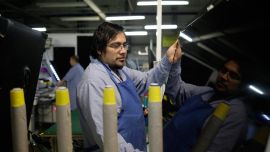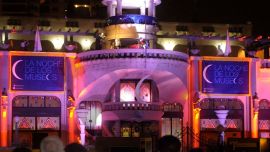The sound of drums and the wail of whistles filled the air this weekend in the city of Gualeguychú, home to the largest Carnival celebration in Argentina.
With seats filled to the brim every weekend since January 7, the comparsa clubs of Entre Ríos have delivered nights packed with music, dancing, and thousands upon thousands of feathers.
Yet there is more at stake than merely audience favour. Every year, local comparsa clubs, each representing different neighbourhoods in the region, pit their floats and costumes head-to-head to determine the year’s winner. With such high stakes, the creativity of Gualeguychú is put on full display.
One of the clubs, Papelitos del Oeste, decided to pay tribute to its roots this year, drawing inspiration for its floats from the people and places which have made Carnival special to them. With an overarching theme of storybook fantasy, their floats blur the line between real and imaginary.
Featuring titles like “The Flute Player of Barrio Oeste” and “Juancho de Oz,” the club playfully incorporates itself into some of the world’s most famous tales.
“The books on the floats are a tribute,” said Martín Naef, one of the lead engineers and designers for the Papelitos floats. “Everything is a little reminiscent of things that are typical of the neighbourhood.”
Discussing the planning and preparation going into each year’s festivities. Naef says it is practically a year-long event.
“We worked for seven months,” he explained. “We have groups here all year round who, as soon as Carnival ends, collect all the feathers and everything related to costumes…it’s an entire process.”
To Naef, the work is more than worth it. “This honestly doesn’t feel like work to us. I get an immense amount of pleasure out of it. Once I discovered what I enjoyed doing with my life, I completely dedicated myself to it.”
This sentiment is one shared by many of the people who make the Carnival parade possible, regardless of affiliation.
“It’s a dream,” said Emmanuel Pérez, who is in his first year as director of the Mari Mari club. “I had never ever dreamed I would be the director of a comparsa. This has always been my home…I have always dedicated myself to the creation of these floats.”
Although working in the Carnival parade has been an aspiration for many, Pérez acknowledges as a director the current hardships which impact upon the celebrations.
“The most influential thing is the economy we are suffering in Argentina,” he added. “We are not in a good moment…We work with many imported materials, especially fabrics, some of which we can no longer access. Many things are becoming expensive for us.”
Despite this setback, Pérez believes the continued success of the Carnival is a testament to Argentine ingenuity.
“The carnival has been growing in spite of everything based on the creativity of the people who work,” said Perez. In finding inventive uses for materials on hand, the city of Gualeguychú has continued to put on bigger and better shows, he explained.
All of this pomp and preparation builds up to February 25 today, when the winning club will be announced. Yet those who had the privilege to watch these works of art ride by will attest they themselves won by a landslide.

























Comments